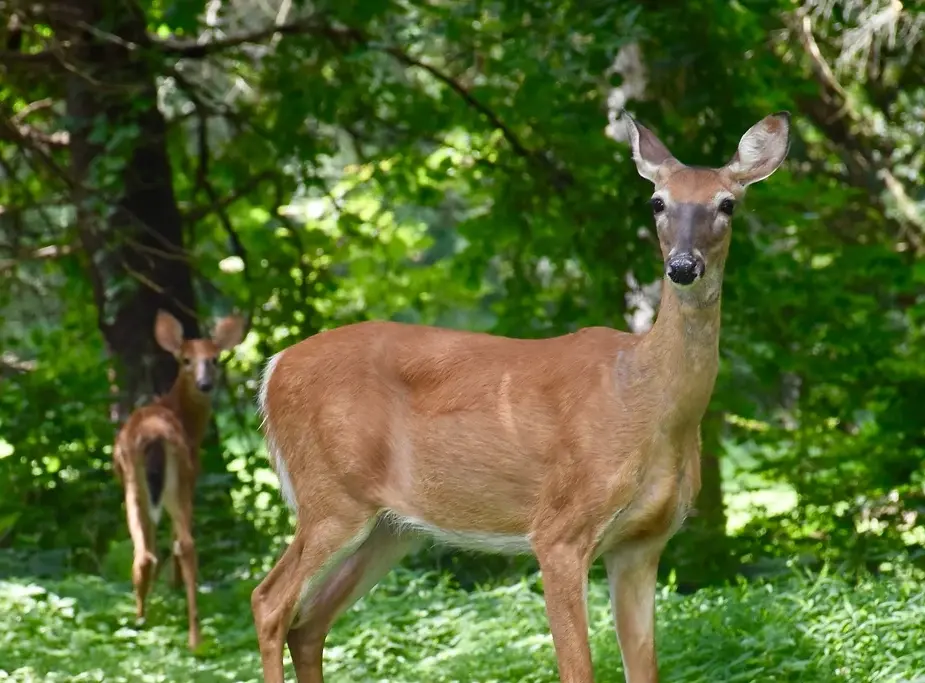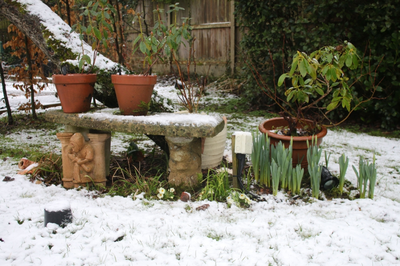
Preventing Deer Damage
Think a tall fence is the only sure way to keep deer out of your landscape? Think again!
Deer can be a year-long problem. In winter, when deer are most hungry, they browse whatever they can find. In the spring and summer, they're a problem for tender crops and flowers. In fall, ripening fruit tempt them. Most deer damage occurs in late fall through early spring, when the animal’s natural food source is scarce.
A mature deer can consume up to 10 pounds of food each day and a hungry deer will eat just about everything. Deer have no front teeth but strip bark by raking their incisors upward, making two-inch gouges in trees. They also tear off foliage when they eat, leaving ragged edges.
Deer are creatures of habit and are difficult to deter them once they have established a feeding area or pathway. Most deer feed in the late evening or very early morning so it’s not always easy to observe them.
In addition to browsing, deer trample plants and damage young trees and shrubs by rubbing their antlers on trunks and limbs.
Deer are adaptable and learn quickly. The most effective way to limit the amount of damage they can do is use a combination of control strategies. Installing a fence, apply repellents, using scare devices and planting deer-resistant plants are all great ways to deter deer.
While there aren’t completely deer proof plants, there are a number of plants that are deer resistant. By choosing plants that are unpalatable to deer, you can reduce the amount of damage to your landscape. Plants that taste bitter or spicy, have a milky sap, thorny plants, or plants with hairy or fuzzy leaves are less attractive to deer. Stop by your local Buckerfield's store and speak with one of our garden centre advisors to help you choose the best deer resistant plants, shrubs and trees.
Motion Detectors
Deer are easily startled so a motion detector works fairly well. When an animal is detected, a valve opens up and instantly releases a pulsating spray of water. The combination of the sudden noise, movement, and water frightens deer away. Connect two or three of them together if you have a large area to monitor.
Motion activated sprinklers work by using infrared sensors to detect the animal’s heat and movement, and spray a quick burst of water when the animal gets near the protected area. Motion activated floodlights, whistles and other noisemakers can also offer effective deer control.
For electronic repellents and motion detector sprinklers, be sure to move the units around your yard after a period of time.
Wire Fencing For Deer
With long powerful legs a deer can bound at 30 mph and jump a 9 foot fence in a blink. Once deer have gotten inside your yard and discovered the crop, it is harder to keep them out.
The most effective long term solution to prevent deer damage is to install a tall 8’ to 10’ fence. Deer can easily jump a 9 or10 foot high fence, but prefer not to, they would sooner go under or through an opening in the fence.
The conventional deer-proof fence is 8 feet high and made of woven wire. No gaps should exist in the fence and access should be through gates that are closed at all times. The fence should have a 6 foot clear perimeter outside the fence, so deer need to cross an opening before encountering the fence.
Electric Fencing For Deer
Electric fence using a wide colored tape enhances protection by being visible to deer, even at night, while providing a shock on contact. The effect that being shocked by an electric fence has on deer behavior, and their subsequent avoidance of the fence, allows a landowner to install a lower fence.
Electric fence put up immediately after planting crops, always kept hot, baited and maintained, can be very effective in protecting crops and keeping deer out.
Deer are extremely well insulated with fur over their bodies and with the tendency to go under or through a fence it is easy to see how deer can get through an electric fence without getting shocked too badly. Keep the bottom wire 12 inches and a second wire 36 inches above the ground.
Baiting the fence is simple and enhances the deterrent powers dramatically by administering a safe correction that trains the deer to stay away. Once the deer touches the bait, the electric fence delivers a harmless static shock to scare deer away. Use a smear of peanut butter to bait the fence and encourage the deer to make contact with the fence using its nose and tongue. Wet parts of the animal conduct the electricity providing a shock.
This first contact and the resulting shock will educate a deer to stay away and respect the fence. Space the bait about 30 feet apart and keep baited as new deer may enter the area.
Deer seem to respect and respond better to electric fencing after they become familiar with the fenced area. The baited fences attract deer to the fence, instead of what’s inside the fence, and provide a shock to keep them away. Keep in mind it is the electric shock that provides the deterrent not the height or strength of the fence.
Deer Repellents
Deer have a highly developed sense of smell and taste, so make sure you use a repellent that smells or taste awful to deer. Liquid formulas can be sprayed directly on plants one taste or sniff and the deer will not want to revisit your yard again.
Repellents can be effective in deterring deer, especially if applied in early spring before deer have gotten into the bad habit of eating your garden, plants or trees.
Contact repellents are applied directly to plants, causing them to taste bad while area repellents are designed to repel by odor. Do not use them on or near food crops.
- Apply repellents on a warm dry day when temperatures are above freezing.
- Deer browse from the top down so apply to a height of 6 feet above the maximum expected snow fall.
- Deer repellents need to be consistently applied and reapplied as directed on label. Make sure you re-apply liquid repellents after heavy rain or snow.
- You can condition deer to stay away, so get on a repellent schedule and make sure to stick to it.
Netting
Use burlap, plastic or wire netting around individual seedlings and small trees to reduce deer damage.
If you’re having trouble with deer in one particular area of your lawn or garden, try placing chicken wire flat on the ground around your plants. Deer dislike getting their feet tangled and will often avoid stepping on the wire fencing.
Wondering where to find deer fencing? Stop by any of our nine Buckerfield's store locations across BC for a large selection of deer fencing, deer deterrents and deer resistant plants.
Have more questions? Visit your local Buckerfield's and we'll be happy to help!



